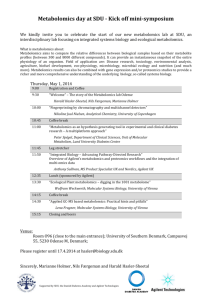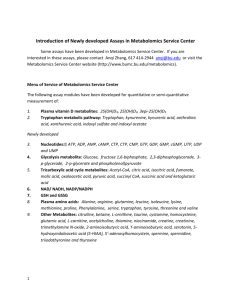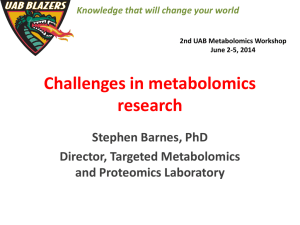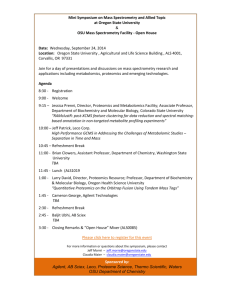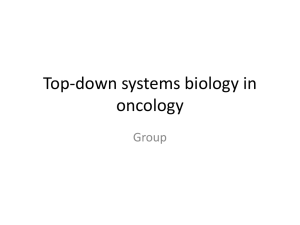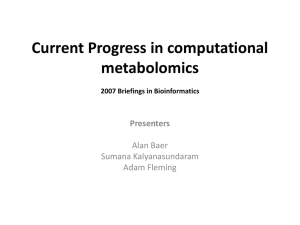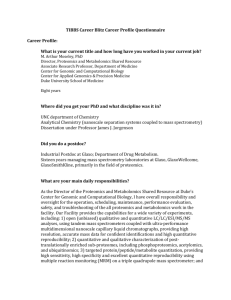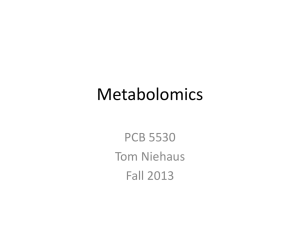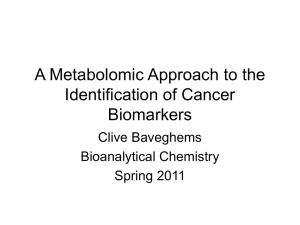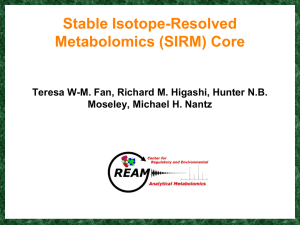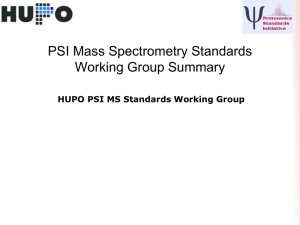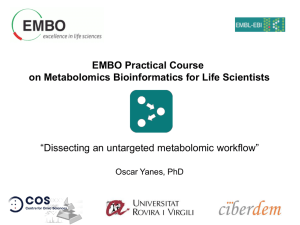MetaboNews Interview Questions_tsana
advertisement
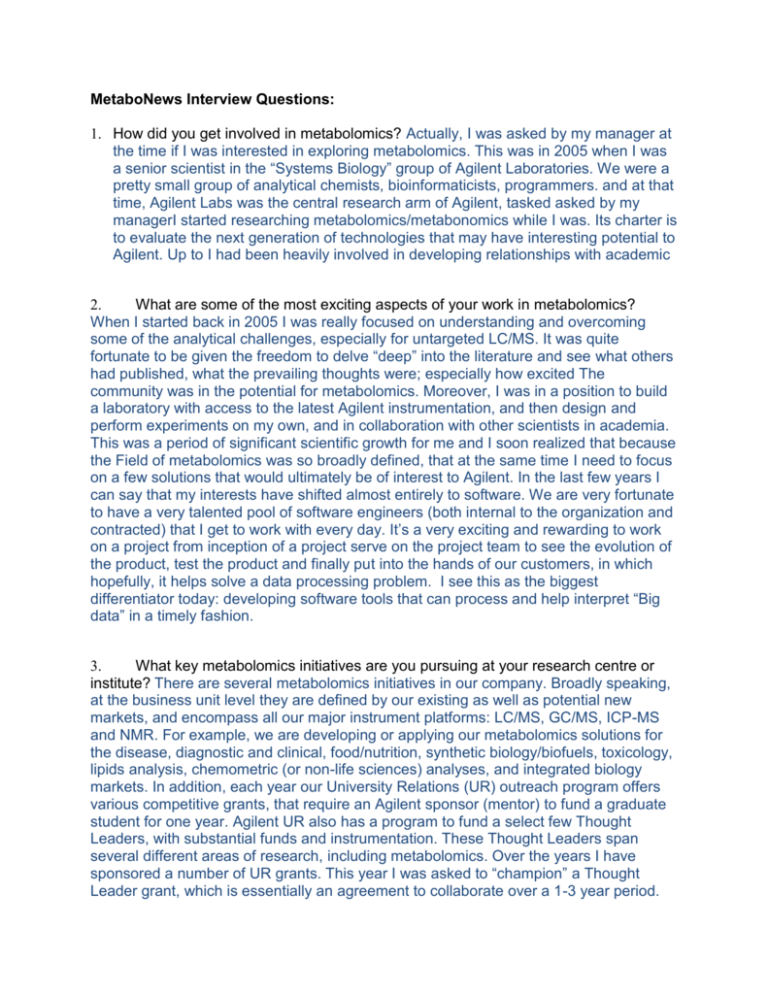
MetaboNews Interview Questions: 1. How did you get involved in metabolomics? Actually, I was asked by my manager at the time if I was interested in exploring metabolomics. This was in 2005 when I was a senior scientist in the “Systems Biology” group of Agilent Laboratories. We were a pretty small group of analytical chemists, bioinformaticists, programmers. and at that time, Agilent Labs was the central research arm of Agilent, tasked asked by my managerI started researching metabolomics/metabonomics while I was. Its charter is to evaluate the next generation of technologies that may have interesting potential to Agilent. Up to I had been heavily involved in developing relationships with academic 2. What are some of the most exciting aspects of your work in metabolomics? When I started back in 2005 I was really focused on understanding and overcoming some of the analytical challenges, especially for untargeted LC/MS. It was quite fortunate to be given the freedom to delve “deep” into the literature and see what others had published, what the prevailing thoughts were; especially how excited The community was in the potential for metabolomics. Moreover, I was in a position to build a laboratory with access to the latest Agilent instrumentation, and then design and perform experiments on my own, and in collaboration with other scientists in academia. This was a period of significant scientific growth for me and I soon realized that because the Field of metabolomics was so broadly defined, that at the same time I need to focus on a few solutions that would ultimately be of interest to Agilent. In the last few years I can say that my interests have shifted almost entirely to software. We are very fortunate to have a very talented pool of software engineers (both internal to the organization and contracted) that I get to work with every day. It’s a very exciting and rewarding to work on a project from inception of a project serve on the project team to see the evolution of the product, test the product and finally put into the hands of our customers, in which hopefully, it helps solve a data processing problem. I see this as the biggest differentiator today: developing software tools that can process and help interpret “Big data” in a timely fashion. 3. What key metabolomics initiatives are you pursuing at your research centre or institute? There are several metabolomics initiatives in our company. Broadly speaking, at the business unit level they are defined by our existing as well as potential new markets, and encompass all our major instrument platforms: LC/MS, GC/MS, ICP-MS and NMR. For example, we are developing or applying our metabolomics solutions for the disease, diagnostic and clinical, food/nutrition, synthetic biology/biofuels, toxicology, lipids analysis, chemometric (or non-life sciences) analyses, and integrated biology markets. In addition, each year our University Relations (UR) outreach program offers various competitive grants, that require an Agilent sponsor (mentor) to fund a graduate student for one year. Agilent UR also has a program to fund a select few Thought Leaders, with substantial funds and instrumentation. These Thought Leaders span several different areas of research, including metabolomics. Over the years I have sponsored a number of UR grants. This year I was asked to “champion” a Thought Leader grant, which is essentially an agreement to collaborate over a 1-3 year period. Our laboratories engage on DOE, analytical methodologies and optimization, and data analysis. Software training is always a big part of this. Typically this can take up 10% of my time and so I’m involved in only one Thought Leader program at any time. 4. What is happening in your country in terms of metabolomics? Although I’m personally based in Santa Clara, California, Agilent is a global company, with many centers in many different countries. There are certainly regionally specific requests and areas of research focus that one finds to predominate in certain regions over others. For example, in China there are many requests for metabolomics analysis of traditional herbal medicines that does not occur in other countries. In recognition of both the emergence and importance of metabolomics in the United States, the NIH Common Fund has recently announced that it aims to invest over $50.0 million in metabolomics grants over the next five years. Several Regional Comprehensive Metabolomics Resource Cores, the recipients of these funds, have recently been announced, including one at UC Davis, here in California. Their mandate is to increase the awareness and the research capacity for metabolomics across the USA. 5. How do you see your work in metabolomics being applied today or in the future? The work that I have done in metabolomics has always been part of a group effort. Whether that has impacted how we recommend doing metabolite extractions from samples, or the development of various columns and hardware solutions, and especially software, this has always been a team effort. I find great satisfaction when our customers our successful in conducting their research based on some or all of our solutions and recommendations. That is how I would like to see it continue into the future as new products are developed. 6. As you see it, what are metabolomics’ greatest strengths? I think the greatest inherent strength of metabolomics is in being the closest “omic” to the phenotype of an organism. I think it also has tremendous potential as a scientific discipline to help validate or refute our current understanding of biological pathways, identify novel metabolic pathways, and become a critical tool for systems biology and synthetic biology applications. 7. What do you see as the greatest barriers for metabolomics? I think a significant barrier remains the challenge of unambiguously identifying metabolites. Untargeted or discovery based metabolomics requires sophisticated, expensive instruments, several different separation and detection technologies for comprehensive analysis, and well trained analytical scientists. The issue of standards has also been raised in the past. There have been a few attempts to begin addressing this very important issue, which I think will require agreement and coordination between academia, industry and instrument manufacturers. What improvements, technological or otherwise, need to take place for metabolomics to really take off? That’s a really good question and I wish I knew all the answers! I can say that it will require (a) minimizing technical variability through automation, (b) minimizing analytical variability through the routine inclusion of common sets of standards; robust, routine separation and detection technologies, (c) QC metrics for an experiment, analogous to the common practices adopted for microarrays---such as Agilent arrays, and finally (d) software, software, software! 9. How does the future look in terms of funding for metabolomics? I see an increased recognition by funding agencies for the importance of metabolomics. So the funding situation looks strong. I think many scientists who traditionally have been well funded experts in proteomics, are now incorporating metabolomics technologies in their laboratories as well. 10. What role can metabolomics standards play? There is certainly a role for standards. I think we must recognize that metabolomics is a broad field, and often analytical chemists, biologists and clinicians don’t always have shared views on this subject. So there has to be compromise and it has to be affordable. I certainly support the NIH sponsored Metabolomics Standards Workshop and efforts such as these to propose common standards for reporting metabolomics results 11. Do you have any other comments that you wish to share about metabolomics? I think these are exciting times for students entering metabolomics as it has such broad applications, particularly towards improving our quality of life: whether through profiling environmental metabolites and metabolic by-products in the soil or water, or plant phytochemicals, in food, health, disease, tailoring drug dosage in pharmacometabolomics for “personalized” medicine, or “Green” technologies such as biofuels--there is plenty of room for both R&D. I also see metabolomics as a great example of a where academia and instrument vendors with strong R&D programs can combine forces to tackle some of the difficult problems. Finally, I would like to dedicate this article to the memory of a dear colleague of mine, Alan Kuchinsky, who passed away this summer. Many readers, especially those in the Cytoscape community will recognize his name. He was responsible for my transferring from R&D to the Systems Biology group in Labs. His work ethic and dedication to his academic collaborators; some of the leading research groups in Systems Biology, served as an example of Agilent Labs’ spirit for both identifying and developing key technologies that ultimately benefit our customers.
